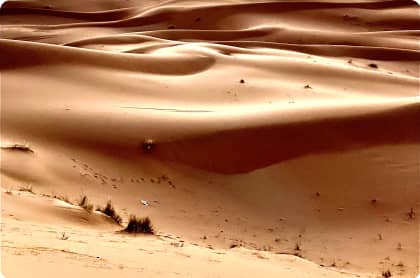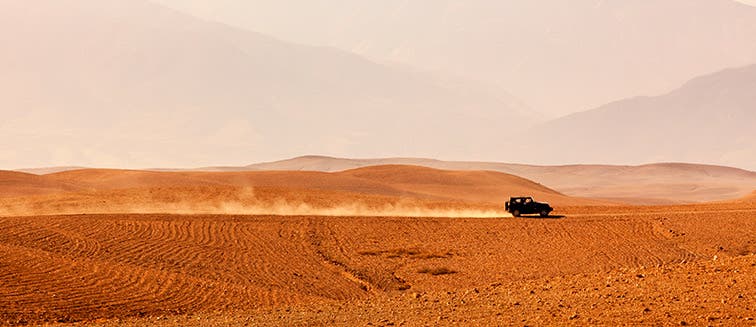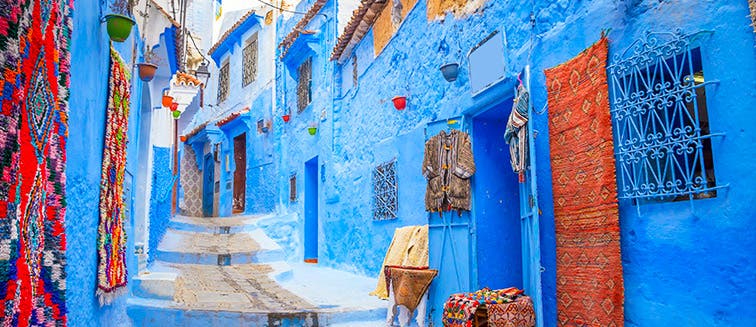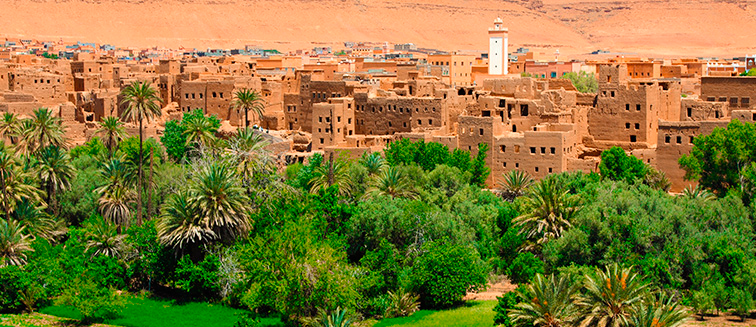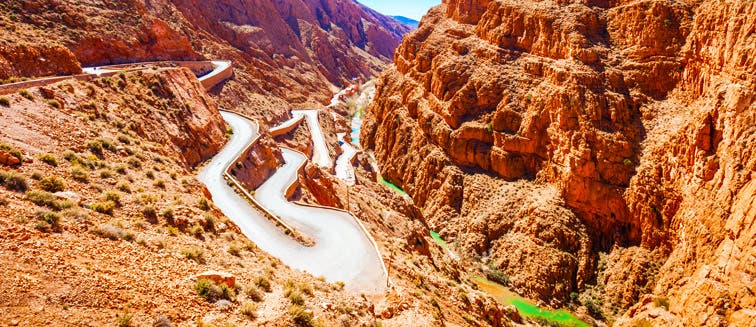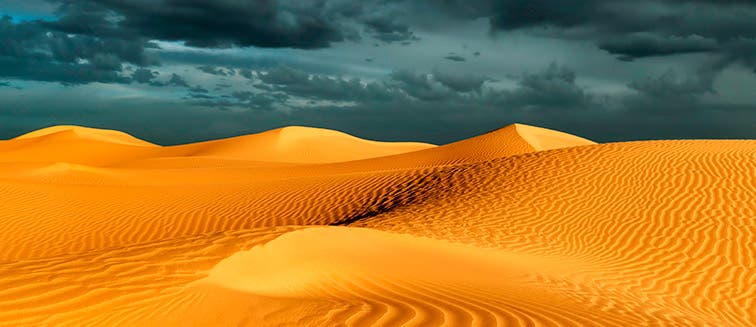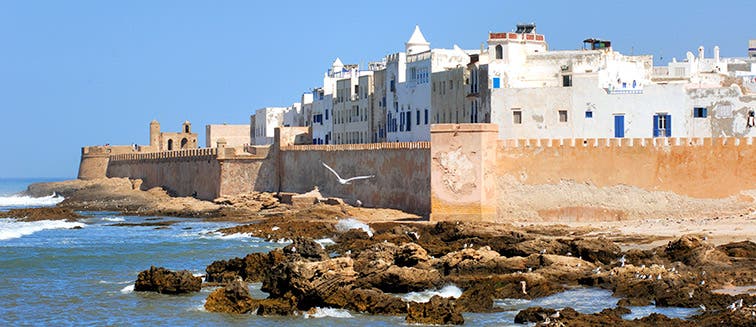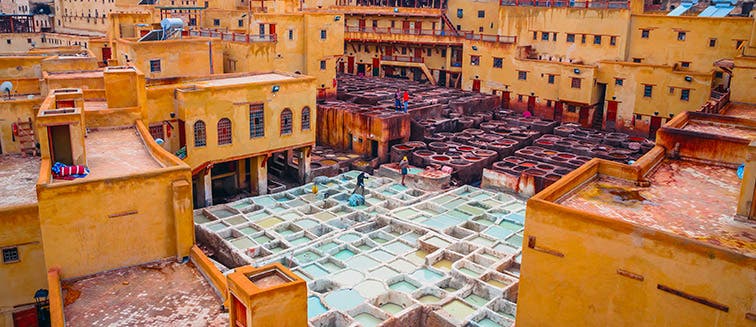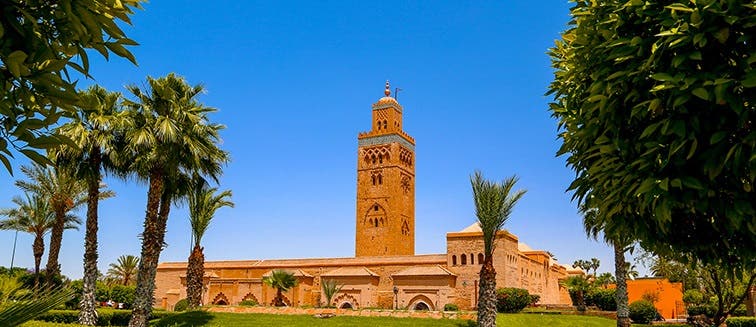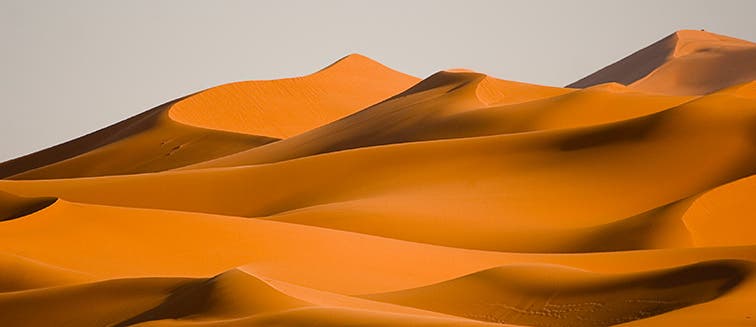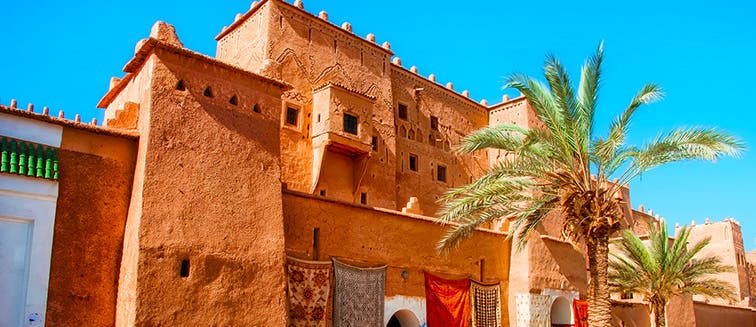A holiday to Morocco is an adventure into a country of rich landscapes. From its famous fortified villages, better known as kasbah, its huge ocher-colored dunes of the Sahara, the green of its large palm groves and high snow-capped mountains, to its labyrinth-like medinas and bazaars. Below, we show you the reasons why choose a trip to Morocco is worth it.
Geography of Morocco
The Kingdom of Morocco is located in the northwest of the African continent, in the so-called Maghreb region. It borders the Mediterranean Sea to the north, Algeria to the East, the Sahrawi Arab Republic to the south and the Atlantic Ocean to the west. The capital is Rabat, but the most populated city is the famously immortalized Casablanca.
Morocco’s almost 36 million inhabitants are distributed in the 16 regions in which the country is divided. These, in turn, are subdivided into 27 prefectures and 45 provinces. Arabs and Berbers represent the majority of the population, although there is also an important Jewish community.
The country has two major mountain systems: the Rif, which borders the Mediterranean coast, from the Muluya River to the Strait of Gibraltar and whose highest peak is Mount Tidighine at 2452 metres; and the Atlas mountain range, a must visit on any tour to Morocco, formed of three mountainous massifs: the Great Atlas to the south, where the highest mountain in the country is found, the Central Atlas and the Anti Atlas that reaches out to the Atlantic coast.
Between the Rif and the Central Atlas stretches the valley of Sebú. To the east of the country are the High Plateaus and to the south the great desert of the Sahara. The most important rivers are the Oum-er-Rbia and the Sebú, which flow into the Atlantic and the Muluya, which flows into the Mediterranean.
The official language is Arabic whilst the Berber languages of Tarifit, Tashelhit and Tamazight, are spoken in the Souss, the Rif and the Atlas. Most Moroccans speak French, which is used commercially and there is also a small Spanish-speaking population.
Islam is the official religion and 98.3 percent of the population is Sunni Muslim, with the king being the highest authority.
The country is a constitutional monarchy with an elected Parliament. King Mohamed VI holds broad executive powers and directs military forces.
In the economic context, income comes from services, agriculture, and the mining industry, phosphate, food, leather, textiles, and tourism, with infrastructures prepared to accommodate countless organized travel options and package holidays, from upscale resorts to cozy medina riads.
The climate varies between the desert of the south, the Mediterranean of the north and the continental of the interior, with temperatures ranging between 10 and 25 degrees Celsius, although in certain areas of the country it can occasionally reach up to 50 degrees.
The flora of Morocco is one of the richest in North Africa with some 4200 species. It is the country with the largest forests in the Maghreb, which contain cork oaks, holm oaks, conifers, junipers, cedars, firs, pines, argan, thorns, while in the arid zones there are date palms. As for the wildlife, there are foxes, rabbits, otters, squirrels, gazelles, wild boars, baboons, panthers, ibis hermits, and horned vipers.
History of Morocco
Morocco is an ancient nation and as such, it has a long and fascinating history. The human presence in the territory dates from the year 8000 BC. Since then, a long list of communities has left their marks on the land. Fishermen and breeders of Saharan horses arrived around 2500 BC, joining the indigenous populations. At the end of 800 BC, Phoenicians and Africans arrived from the East and the Romans eventually invaded in the 4th century BC. Continuous challenges and rebellions on the part of the Berbers towards the Roman Empire resulted in the expulsion of Romans in the 5th century. Vandals, Visigoths, and Byzantines succeeded the Romans, although the lands of the high mountains were always dominated by the Berbers.
In the 7th century, the indigenous Berbers, Jews, and Christian converts, were aware of the new religion founded by Mohammed bin Abu Talib, the prophet Muhammad, who revealed that there is only one God and that believers share the common duty of submitting to his divine will. Following his death, in the year 632, Islam spread to central Asia and western Africa.
The Umayyad leader Uqba bin Nafi reached the Atlantic coast of Morocco in 682 but failed to break the Berbers. It took time and compatibility with the concepts put forward by Muhammad, which emphasized the duty, courage, and loyalty of the group, which led to the conversion of many in Morocco to Islam. Through diplomacy, the Umayyads managed to impose themselves in the country in the 8th century, although in the middle of the century they were exiled and the new leaders dominated the trade of silver, gold, and slaves.
In the year 786 the descendant of Muhammad, Idris I, fled to Morocco, was appointed imam or religious leader by the Berbers, unified the north of the country and converted Fez into the capital. Their descendants expanded the power of the dynasty in the north of the country and part of Europe.
Meanwhile in the south, a detractor prophet established an illegitimate Islam, and the behavior of the military in the area, caused a dissatisfaction that led to the emergence of the Sanhajas, a Berber tribe of tenacious warriors from the Sahara, who created the dynasty of the Almoravids with its capital in Marrakech, which was later razed by the Almohad Berbers in 1147, ending with the power falling into the hands of the successors of Emir Ben Ali Ben Youssef.
The Almohad defeat came in 1269 at the hands of the Berbers who established the Benimerin dynasty, during which madrasas were built in the important cities and whose empire was devastated by the plague and by the continued assassinations of the leaders at the hands of their advisers. From 1420, the Wattasíes began to exercise control and in 1465 the last Sultan Merinid Abd al-Haqq was killed. In spite of everything, they were not able to consolidate their power, as the Portuguese possessed dominion over the main ports of the country by the beginning of the 16th century. Melilla was conquered by the Spaniards in 1497. The Berber Saadians of the Draa Valley fought against the Lusos, restoring internal trade and European markets which supplied sugar, ivory, gold, and slaves. The Saadian dynasty ruled the south until 1554 and the entire territory until the death of Sultan Ahmad el Abbas in 1659. The indulgent nature of the Alaouite Kingdom allowed Jews to demarcate their own neighborhoods or mellah in several of the cities.
The sixth Sa'did Sultan, Ahmad I al-Mansur, was the most famous of the dynasty. He built the great palace of Marrakech and participated in alliances with Christian economies until his death in 1603. The civil war of 1620 to 1627 led to the fall of the Saadians and the arrival of Alawites, descendants of the illustrious Muhammad. The reign of the second ruler, Mulay Ismail, was based on despotism and cruelty, and the capital was moved to Meknes. The Alawi dynasty lasted until the twentieth century.
France allied with the Berbers around 1830 and Spain took over some northern cities such as Ceuta. In 1880, Europeans and Americans established duty-free trade in Tangier. Under the Sultanate, the Algeciras Conference was held in 1906, in which it was agreed to hand over the management of banks, customs and Moroccan policy to France and with the Treaty of Fez in 1912, the country became a French protectorate.
In 1944, the Independence Party demanded the end of the French mandate with the support of the United States and the United Kingdom. France allowed the king to return to his country in 1955 and independence was achieved in 1956.
The dissatisfaction of Moroccan society for inequality between rich and poor and tax burdens, together with half political unrest, led to large protests in Casablanca in 1981, to which the Government responded with violent repression that resulted in deaths and imprisonment. But popular activist pressures led the king to found the Equity and Reconciliation Commission with the aim of investigating the human rights abuses that occurred during his reign. His successor since 1999 and until today, Mohammed VI, guaranteed the repair of the damage caused to the victims of the so-called "Years of Lead" by means of indemnities. The monarch has made great democratic changes, but the Casablanca attacks of 2003 resulted in the deduction of some civil liberties.
The traces of a past of emperors, warriors, viziers, sultans, and settlers, has created a social fabric that surprises the gaze of the western traveler. A tour to Morocco is the best way to gain insight into the complex history of this country.
Why is Morocco Africa’s most visited country?
The light falls on Morocco in a unique way, so that the colors warmth and harmony of the landscapes are unlike those seen anywhere else. From the pure and exciting tones of nature, infinite color combinations are born with which towns and cities have integrated themselves.
Morocco exhibits pure life, showing itself in all its splendor amidst the bustle of its busy and nocturnal streets and squares. Away from the noise, the deafening silence of the desert, a treasure of the country, is where you can experience the most exciting adventures.
A package holiday to Morocco will give you the opportunity to experience many things, from finding yourself lost in labyrinthine medinas; counting millions of stars in the cold nights of the desert; entering the arid landscapes of mountain ranges; smelling the aroma of mint tea and spices; admiring the iconic belly dance; being captivated by the majestic architecture of arches, stuccos, mosaics and carved wood of the imposing monuments to listening to the eternal call to prayer.
Morocco is the pearl of North Africa and the jewel of the Arab world. Morocco is not a mirage, it is a fantastically real illusion.

